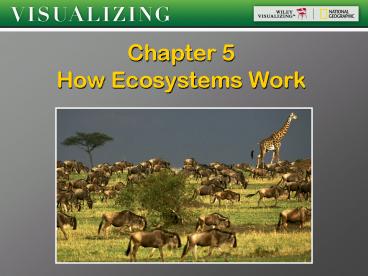Chapter 5 How Ecosystems Work PowerPoint PPT Presentation
1 / 39
Title: Chapter 5 How Ecosystems Work
1
Chapter 5How Ecosystems Work
2
Lake Victoria
- Freshwater lake in Africa
- Formerly home to 400 species of cichlids
- 1960 Nile perch
- introduced
- 1990 water hyacinth
- invaded
- Today, ecological
- imbalance why?
3
What Is Ecology?
- Literally study of ones house
- Interactions
- Two components
- Biotic
- Abiotic
- Broadest biological field of study
4
Ecological Organization
- Organism
- Population
- Community
- Ecosystem
- Landscape
- Biosphere
5
Goals Of Ecologists
- Understand how ecosystems function
- Make connections landscape ecology
- Connections among ecosystems
- Great blue heron
6
Energy
- Capacity or ability to do work
- Flows through ecosystems
- Why do organisms need energy?
- Different kinds
Potential energy
Kinetic energy
7
First Law of Thermodynamics
- Energy cannot be created or destroyed
- Energy can be changed from one form to another
8
Second Law of Thermodynamics
- When energy is changed from one form to another,
some is degraded into heat - Heat is a less usable form of energy
- Increases entropy in the universe
9
Ecosystem Composition
- Producers
- Consumers
- Decomposers
10
Producers
- Make their own food
- Photosynthesis
- Examples?
6CO2 6H2O ------gt C6H12O6 6O2
11
Consumers
- Feed on other things
- Herbivores
- Carnivores
- Omnivores
- Detrivores
12
Decomposers
- Break down dead organisms and waste products
- Examples?
13
Energy Flow
- Energy passes from one organism to the next
- Trophic level each step in this flow of energy
- Food chain straight path
- Food web
- Interconnected food chains
- More realistic than food chain why?
14
Food Chain
15
Food Web
16
Biogeochemical Cycles
- Matter cycles through ecosystems
- Five cycles
- Carbon
- Hydrologic (water)
- Nitrogen
- Sulfur
- Phosphorus
17
Carbon Cycle
- Essential component for life
- Gas (CO2) in atmosphere
- Several forms in ocean
- Can take a long timethink fossil fuels
18
Carbon Cycle
19
Hydrologic Cycle
20
Nitrogen Cycle
- Proteins, DNA
- Atmosphere is 78 N2
- Five steps
- Nitrogen fixation
- Nitrification
- Assimilation
- Ammonification
- Denitrification
21
Nitrogen Fixation
- Specialized bacteria
- Split atmospheric nitrogen and combine it with
hydrogen
22
Nitrogen Cycle
23
Sulfur Cycle
- Underground sedimentary rocks and minerals
- Erosion releases compounds to ocean
- Volcanoes
- Essential component of proteins
24
Sulfur Cycle
25
Phosphorus Cycle
- No atmospheric component
- Phosphates used in DNA and ATP (chemical energy)
- Phosphates move through the food chain
26
Phosphorus Cycle
27
Ecological Niche
- Everything about an organism
- Adaptations
- Use of resources
- Lifestyle
- Habitat
28
Ecological Niche
- Two species cannot occupy the same niche why?
- Resource partitioning
- Reduces niche overlap
- Reduces competition
29
Resource Partitioning At Work!
30
Species Interactions
- No species lives in complete isolation
- Symbiosis
- Intimate relationship between members of at least
2 species - Mutualism, commensalism, parasitism
- Result of coevolution
- Other interactions
- Predation, competition
31
Mutualism
- Both species benefit
32
Commensalism
- One species benefits, other not affected
33
Parasitism
- Parasite benefits, host is harmed
- Ectoparasites endoparasites
34
Species Interactions
- Predation consumption of one species by another
- Coevolution arms race
35
Avoiding Predators
- Mechanical defenses
- Social groups
- Camouflage
- Protective chemicals
36
Species Interactions
- Competition two or more organisms attempting to
use the same resource - Intraspecific vs. interspecific
37
Keystone Species
- Crucial to maintenance of an ecosystem
- Loss affects many other
- species
- Examples?
- This idea is being
- challenged why?
38
Case Study Global Climate Change
- Atmospheric CO2 increased dramatically. Why?
- 10 warmest years have occurred since 1990
- 2005 warmest
- 1998 second warmest
- 2002 third warmest
- Earths temperatures may rise 1.8o 4.0o C
- (3.2o 7.2o F) by end of 21st century
- What could occur?
39
Case Study Global Climate Change
- Kyoto Protocol International climate change
conference Kyoto, Japan 1997 - Highly developed countries to cut
- CO2 emissions 5.2 by 2012
- US Department of Energy
- Automotive vehicles
- designed for better gas
- mileage
- High efficiency wind
- turbines

